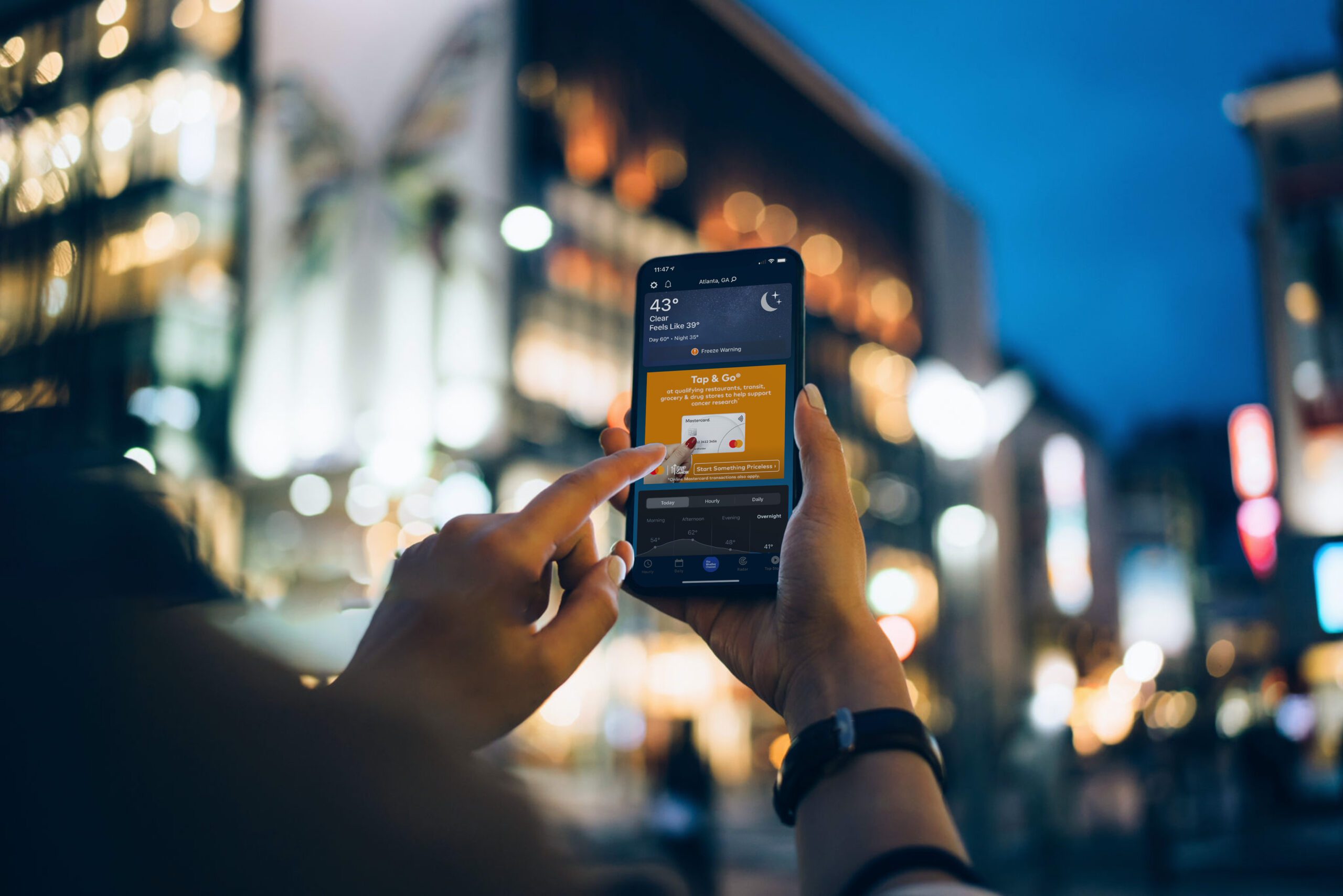Weather intelligence for the future: Crafting a strategic enterprise approach to changing environmental conditions
Continue readingKey takeaways
- Weather-based advertising powered by Weather Targeting delivers privacy-forward personalization by connecting campaigns to real-world conditions.
- The influence of weather shapes audience mood, behaviors, and purchase intent, giving marketers a powerful contextual advantage.
- Hyperlocal weather data equips brands to anticipate demand and adapt campaigns with precision at the ZIP code level.
- Weather-activated ads demonstrate contextual advertising effectiveness across CTV, retail media networks, and programmatic platforms.
What if the most influential marketing signal isn’t hidden in a dashboard, but right outside your window? For years, marketers have optimized for content, time of day, and audience segments. But they’ve been missing the one lever that truly moves the needle: the weather. Weather-based advertising powered by Weather Targeting can transform real-world weather conditions into a marketing superpower. It’s a strategy that delivers context, relevance, scale, and, most importantly, measurable ROI for your campaigns.
What is Weather Targeting?
As data privacy regulations fluctuate and consumer expectations shift, brands are searching for ways to deliver relevance without surveillance. At its core, Weather Targeting is an innovative, privacy-forward strategy that leverages hyperlocal weather data to anticipate human (and consumer) behavior. Instead of relying on identifiers or third-party cookies, Weather Targeting uses AI to personalize and contextualize ad delivery based on real-time and forecasted weather.
By tapping into environmental signals at the ZIP code or neighborhood level, brands can automate media buys for the micro-moments when people are most likely to click, engage, or buy. With Weather Targeting born from decades of forecast expertise, advertisers can deliver relevance without tracking, cookies, or profiles.
Privacy-forward, precision targeting with layered audience signals
Beyond just the forecast, Weather Targeting taps into a broader set of audience signals for deeper relevance, including:
- Relative conditions-based: Align ads with weather mixes like heat, humidity, pollen, or air quality.
- Activity-based: Connect with people during known conditions that align with desired behaviors, such as in-store shopping, outdoor activities, and food delivery.
- Product-based: Use third-party sales data from sources like IRI and NielsenIQ to identify the optimal mix of conditions that lead to incremental sales.
- Health and wellness-based: Leverage privacy-forward signals such as anonymized patient reports, OTC sales data, and prescription sales data from IQVIA, academic journals, medical reports, and medical claims data, to anticipate health-related needs.
- Emotion-based: Tap into the proven connection between weather, mood, and motivation to stimulate consumer engagement.
Each signal is strengthened with weather context and layered with trusted third-party data, making them smarter and more predictive.
Why is weather such a powerful signal in advertising?
So much more than the topic of small talk, weather is the ultimate contextual signal – measurable, scalable, and rooted in the real world. Unlike other contextual inputs, weather influences both emotion and behavior in real time. It universally shapes where people go, what they do, and how they spend.
In fact, weather actually rewires the brain at a subconscious level, where 90% of decisions are made. Four distinct weather-driven “mindsets” – creating, relishing, enduring, and cocooning – influence memory, motivation, and purchase behavior in unique ways. By aligning creative and messaging with specific Weather Mindsets, marketers can meet people where they are — emotionally and neurologically — and boost the effectiveness of every impression. For example, campaigns timed to sunny conditions can see a 10% lift in purchase intent, while stormy conditions can increase emotional engagement by nearly 29%.1
Proven results and ROI
Marketers across industries are already seeing the power of this predictive data science, with measurable results, including:
lift in campaign performance for a leading cold & flu brand by activating ads ahead of rising seasonal illness trends.2
increase in sales for a quick-service restaurant (QSR) chain by syncing warm-food promotions with incoming cold weather.3
surge in ad awareness for a national retailer when localized weather conditions were used to dynamically align creative.4
more foot traffic for a department store when campaigns matched weather-driven consumer mood.5
higher engagement for a travel bureau when snowy conditions prompted warm-weather getaway ads.6
stronger CTR and a 7% lift in purchase intent for TruFuel by syncing generator messaging with severe weather.7
With predictive weather-based advertising, brands can plan and launch campaigns before consumer intent spikes – reducing wasted spend and maximizing ROI. The scale is unmatched: The Weather Company delivers insights across 44,000 ZIP codes and billions of intent signals monthly. It’s no surprise that this strategy drives results across industries and advertising channels.
Why are retailers turning to weather strategies?
Retailers are increasingly investing in weather-based advertising because it delivers measurable performance without compromising privacy. Weather emerges as a future-proof signal – objective, real-time, and universally understood. In fact, the data shows:
- 40% of daily retail sales variance is due to weather8
- 50%+ of consumers say their skin and hair needs change with the weather9
For retail brands, weather adds dynamic, real-world context that explains shifts in demand and helps tailor promotions to local conditions. A grocery chain can spotlight grilling supplies ahead of a warm weekend, while a clothing retailer may drive outerwear sales during the first cold snap. Even home improvement and DIY brands see measurable lifts when campaigns align with rainy-day or storm forecasts.
Retailers also value the geographic precision that hyperlocal weather data provides. Messaging can be adapted across ZIP codes, cities, or regions, accounting for the nuances that national campaigns often miss.
Ultimately, weather strategies allow brands to market with relevance at scale. Effective campaigns focus on real conditions, real needs, and real results.
Real-time responsiveness: Adapting campaigns to changing weather
When weather changes, consumer priorities shift – often quickly. Businesses that build flexibility into their marketing strategy can adapt in near real-time, reaching consumers with contextually relevant messages precisely when demand increases. The key lies in using weather as a reactive tool and a proactive signal for planning, activation, and optimization.
Short-term weather events – like storms, heatwaves, or cold fronts – can have immediate impacts on foot traffic, product interest, and purchase urgency. As a result, businesses that connect marketing to these conditions can shift ad spend toward the highest-performing regions, adjust creative assets to reflect the moment, and emphasize products suited to the current environment – all automated by Weather Targeting technology.
For example, a national retailer aligned its store promotion strategy with regional weather shifts by deploying warmwear and hot beverage promotions ahead of a cold front. The campaign produced a 12.2% lift in foot traffic, amounting to over 94,000 incremental store visits.10
The rise of real-time, weather-based advertising allows for even more responsiveness. Brands can deploy creative variations tailored to specific conditions (humid, overcast, chilly) across ZIP codes, adjusting message and tone to match local experiences. It’s marketing that feels alive, because it is.
How weather amplifies your marketing calendar
Some of the most effective advertising campaigns connect with audiences during shared cultural moments, big and small. But what amplifies those campaigns isn’t just the calendar. It’s the weather. Weather-based advertising allows brands to align creative with the season and how that season feels in a specific location at a specific time.
Football season
From planning moments leading up to the game to tailgates and watch parties, fall football traditions are deeply tied to the weather. As temperatures drop, fan rituals shift toward warm food, seasonal apparel, and outdoor gear. Brands can activate campaigns when the first chill hits, serving ads for chili ingredients, fleece pullovers, or team gear.
Halloween
Halloween shopping is often driven by short-term weather conditions. A sunny weekend in mid-October may drive costume purchases and outdoor décor, while a soggy forecast can spike demand for indoor entertainment or candy.
Entertainment
Weather directly impacts what people choose to do in their downtime. Rainy days or chilly nights often increase interest in streaming services, movie rentals, or cozy at-home activities. Weather-activated ads that promote these entertainment experiences at just the right moment can drive engagement and viewing time without needing personal data.
Holidays
Holiday campaigns often follow fixed calendars, but consumer behavior doesn’t. A sudden cold front can kickstart interest in warm beverages, travel deals, and gift planning – well before traditional campaign dates.
Weather Targeting helps brands tap into cultural moments using real-time environmental context. This elevates seasonal advertising from reactive to anticipatory. It also makes brand messaging feel perfectly timed.
Activating weather data in your media plan
Brands and agencies are integrating weather-based advertising across high-impact channels like connected TV (CTV), retail media networks (RMNs), and programmatic curation.
Within CTV
CTV offers a high-attention environment where mood and timing matter. By using weather-activated ads, brands can tailor creative to match a viewer’s emotional state or physical environment – without relying on identifiers.
Within RMNs
RMNs are increasingly central to retail strategy, and hyperlocal weather data adds a predictive layer that enhances their power. Retailers and brands gain the ability to segment campaigns by location, weather condition, and season, offering meaningful experiences without user tracking. Easy integration through Deal IDs or programmatic platforms helps Weather Targeting scale quickly across campaigns, without additional operational complexity.
Within programmatic curation
Programmatic curation allows marketers to pre-package inventory with enhanced context. Adding weather data enriches curated deals with real-world signals so impressions reach consumers at the right moment.
Why The Weather Company?
When every marketing dollar counts, you want to know you’re getting the most accurate weather intelligence possible fueling your campaign. With decades of data and proprietary AI forecasting models, we are nearly 4x more likely to be the most accurate than our closest competitor.11 As the global leader in contextual weather intelligence, The Weather Company powers over 2 billion daily forecasts across 178 countries, integrating into CTV, RMNs, programmatic platforms, and beyond. We forecast weather and help brands forecast demand.
Outsmart the competition with a weather-based strategy
As data privacy becomes the new standard, relying on outdated strategies is a risk. Weather-based advertising is the future-ready solution that lets you win on relevance, not personal data. Whether you’re planning for peak season or optimizing your always-on campaigns, The Weather Company can help you connect with consumers in the moments that matter most.
FAQs
Weather-based advertising is a strategy where ad delivery is aligned with real-time or forecasted weather conditions, using hyperlocal weather data and AI to reach consumers in the moments they are most receptive.
The influence of weather extends to mood, routines, and purchase intent. Sunshine can drive shopping and outdoor activity, while rain or cold often increases interest in comfort food, indoor entertainment, or warm apparel.
Hyperlocal weather data makes campaigns more precise by capturing conditions at the ZIP code level. This allows brands to personalize messages based on what consumers are actually experiencing in their exact location.
The importance of weather data lies in its ability to predict demand shifts. Retailers use it to optimize promotions, align inventory, and improve forecasting to reduce waste and boost ROI.
Weather-activated ads are creative assets that change automatically based on live conditions, such as showing cold-weather promotions during a frost or highlighting sunscreen when UV levels rise.
By aligning with real-world conditions, Weather Targeting boosts contextual advertising effectiveness. It enhances relevance, improves engagement, and drives measurable results without relying on personal identifiers.
Weather Targeting uses environmental signals instead of personal data. This means brands can deliver personalization without cookies, IDs, or surveillance to meet consumer expectations for privacy.
Let's talk
What’s your weather marketing strategy? To learn more about harnessing the power of weather to increase engagement and drive growth, contact our advertising experts today.
Contact us1 Impact of Weather study, Neuro-Insight on behalf of The Weather Company, April 2025. Metrics are based on calculations from the NI study and actual ROI metrics may vary.
2-4 The Weather Company campaign results from participating clients
5-7 Shine through the clouds: Weather’s central role in contextually relevant advertising
8 Journal of Retailing and Consumer Services, The impact of daily weather on retail sales: An empirical study in brick-and-mortar stores, 2019.
9 A beauty strategy that will always be on trend
10 InMarket Q4 2023
11 ForecastWatch, Global and Regional Weather Forecast Accuracy Overview, 2021-2024, commissioned by The Weather Company







